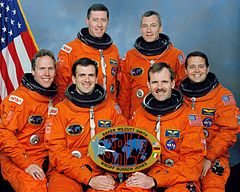STS-68
 | |
| Dane misji | |
| Indeks COSPAR | 1994-062A |
|---|---|
| Zaangażowani | |
| Oznaczenie kodowe | STS-68 |
| Pojazd | |
| Wahadłowiec | |
| Załoga | |
 Rząd górny od lewej: Michael Baker, Terrence Wilcutt. Rząd dolny od lewej: Thomas Jones, Peter „Jeff” Wisoff, Steven Smith, Daniel Bursch. | |
| Dowódca | |
| Start | |
| Miejsce startu | |
| Początek misji | 30 września 1994 11:16:00 UTC |
| Orbita okołoziemska | |
| Apogeum | 212 km |
| Perygeum | 199 km |
| Okres orbitalny | 88,6 min |
| Inklinacja orbity | 57° |
| Lądowanie | |
| Miejsce lądowania | EAFB, Pas startowy 22 |
| Lądowanie | 11 października 1994 17:02:08 UTC |
| Czas trwania misji | 11 dni, 5 godz, 46 min, 08 sek[1] |
| Przebyta odległość | 7 568 744 km[1] |
| Liczba okrążeń Ziemi | 182[1] |
| Program lotów wahadłowców | |
STS-68 (ang. Space Transportation System) – siódma misja wahadłowca kosmicznego Endeavour i sześćdziesiąta piąta programu lotów wahadłowców[2].
Załoga
- Michael Baker (3)*, dowódca
- Terrence Wilcutt (1), pilot
- Thomas Jones (2), specjalista misji 4
- Steven Smith (1), specjalista misji 1
- Daniel Bursch (2), specjalista misji 2
- Peter „Jeff” Wisoff (2), specjalista misji 3
- *(liczba w nawiasie oznacza liczbę lotów odbytych przez każdego z astronautów)
Parametry misji
- źródło[1]
- Masa:
- startowa orbitera: 112 095 kg
- lądującego orbitera: 100 707 kg
- ładunku: 12 510 kg
- Perygeum: 199 km
- Apogeum: 212 km
- Inklinacja: 57,0°
- Okres orbitalny: 88,6 min
Cel misji
Misja z obserwatorium radarowym SRL-2[2].
Zobacz też
Przypisy
- ↑ a b c d Mark Wade: STS-68 (ang.). W: Encyclopedia Astronautica [on-line]. [dostęp 2017-07-25].
- ↑ a b c Tomáš Přibyl: Dzień, w którym nie wróciła COLUMBIA. Bielsko-Biała: Wydawnictwo >DEBIT<, 2003, s. 169. ISBN 83-7167-224-1.
- ↑ Robert Godwin: Space Shuttle. Warszawa: Prószyński Media Sp. z o.o., 2011, s. 71, seria: Historia podboju Kosmosu. ISBN 978-83-7648-973-5.
Linki zewnętrzne
- podsumowanie misji STS-68 na stronie KSC (ang.)
- Mark Wade: STS-68 (ang.). W: Encyclopedia Astronautica [on-line]. [dostęp 2017-07-25].
- Spaceflight mission report: STS-68 (ang.). Spacefacts. [dostęp 2017-07-25].
Media użyte na tej stronie
The flag of Navassa Island is simply the United States flag. It does not have a "local" flag or "unofficial" flag; it is an uninhabited island. The version with a profile view was based on Flags of the World and as a fictional design has no status warranting a place on any Wiki. It was made up by a random person with no connection to the island, it has never flown on the island, and it has never received any sort of recognition or validation by any authority. The person quoted on that page has no authority to bestow a flag, "unofficial" or otherwise, on the island.
The crew of the Space Shuttle mission STS-68 described by NASA as follows. :Standing are, left to right, Michael A. Baker, mission commander; and Terrence W. Wilcutt, pilot. On the front row are, left to right, Thomas D. Jones, payload commander; and Peter J. K. (Jeff) Wisoff, Steven L. Smith and Daniel W. Bursch, all mission specialists.
STS-68 Mission Insignia


